Key takeaways:
- Why should anybody integrate project management software with QuickBooks? Integrating project management software with QuickBooks streamlines financial workflows by syncing time tracking, budgeting, invoicing, and expense reporting across platforms. This reduces manual data entry, improves billing accuracy, and fosters clearer communication between project and accounting teams.
- Whats should teams look for in project management software that integrates with QuickBooks? Look for platforms that support real-time tracking, automate data transfers (like hours worked or task status), and provide customizable workflows. The ideal solution should also offer flexible views (e.g., Gantt charts, dashboards) and allow financial data to flow seamlessly into your accounting system.
QuickBooks is one of the most popular financial management platforms on the market. With a robust set of tools for both businesses and accountants, it simplifies the key aspects of a business’s expense tracking and invoicing, and saves time in the process.
But QuickBooks is not a piece of project management software. As your business grows, you’ll need to bring in more tools to give you the same level of control over the other aspects of your projects as QuickBooks gives you over your accounts.
The best solution is to choose project management software that integrates with QuickBooks. This way, you can streamline the flow of information between your project team and your accountants. And with the right integrations, you can do it without overcomplicating your work, overhauling your workflows, or creating gaps in your process.
In this post, I’ll show you the best option for integrating project management software with QuickBooks, so you can scale up your business without abandoning the tools you know and love.
Why include QuickBooks in your project management setup?
Chances are, there will come a time when you can’t effectively manage your work without upgrading your project management system. But swapping basic tools for purpose-built project management software doesn’t mean you have to stop using QuickBooks for your finances. In fact, there are good reasons to stick with the accounting system you know.
Developed and marketed by Intuit, QuickBooks has a lot of strengths as a piece of software. All its pricing plans include some features that can help support your role as a project manager (PM).
For example:
- The quoting and invoicing features organize the financial aspects of project planning and create the clear, professional documentation you send to your clients.
- The income and expense tracking features monitor your budget during project execution.
- The financial reporting and insights tools simplify communications between project managers and their accounting teams.
- The inventory tracking feature (available on the Plus Plan) tracks your stock and sales in real time, so you can manage ordering more efficiently.
These inbuilt tools, available for desktop and the mobile app QuickBooks Online, can give you a thorough understanding of your project’s financial status. However, when it comes to managing complex projects or project portfolios, you will likely need a more comprehensive view of your work.
Though it’s a strong piece of accounting software, QuickBooks doesn’t give you the full project-level overview you might need. It lacks robust scheduling and timeline tools, communication methods, and features that can help with overall resource allocation. The reality is, as essential as financial management is to the success of a project, budget is not the only KPI you need to track.
That’s where project management platforms like Wrike come in.
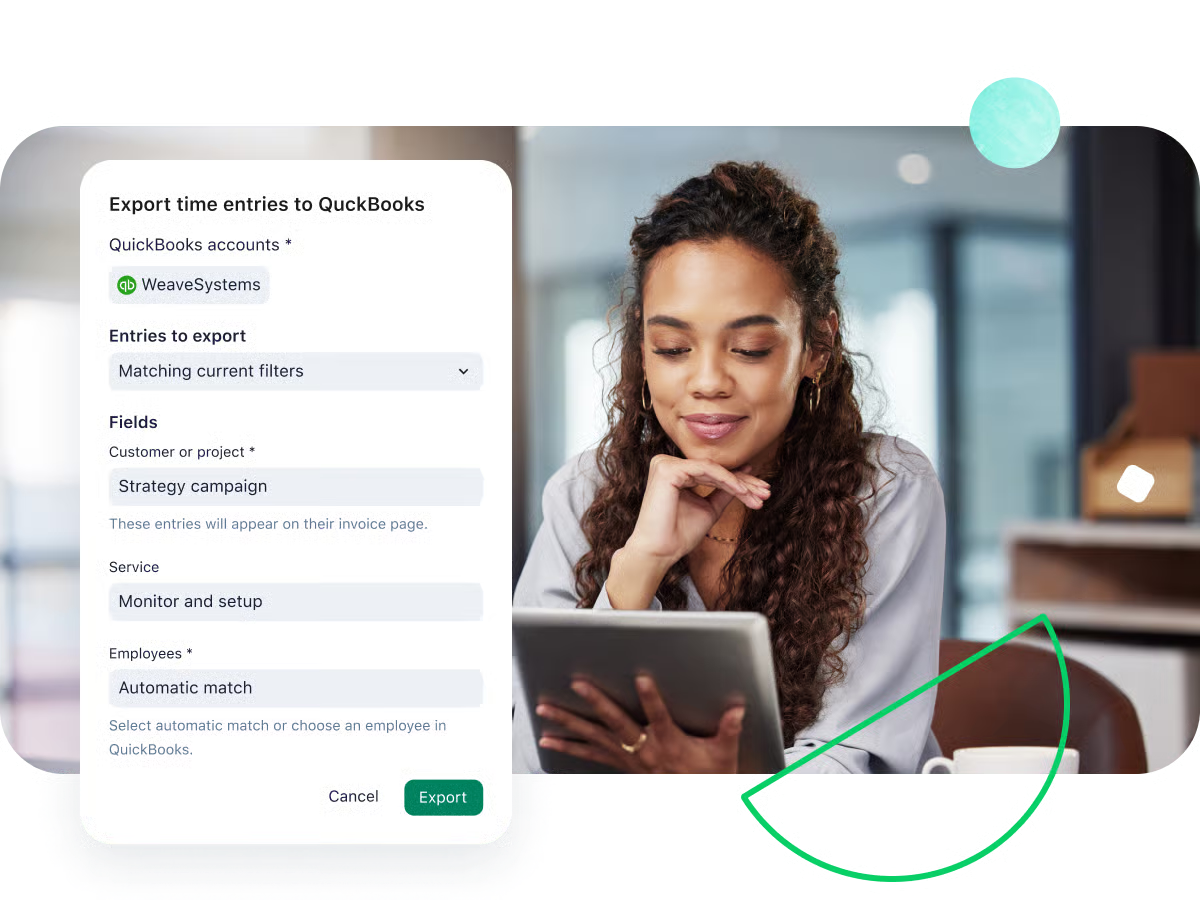
Wrike is a work management solution to streamline projects from initiation to delivery. With our automated task management and workflow features, you can manage and optimize every aspect of your projects, including your financial workflows.
And because Wrike integrates seamlessly with QuickBooks, you can upgrade your processes without disrupting your financial records.
Wrike’s QuickBooks integration explained
When you manage projects in Wrike, our powerful API integrations connect your processes to hundreds of apps that power your work. One popular integration is with QuickBooks. This integration simplifies billing in three ways:
- Exporting: With just a few clicks, you can export the time entries your team members record in Wrike to QuickBooks to be added to your invoices and project budget tracking.
- Syncing: The integration shares billing rates, project services, and client details between the platforms.
- Automating: With simple, rule-based automations, you can set your workflow to export the data automatically at a set point in your financial workflow.
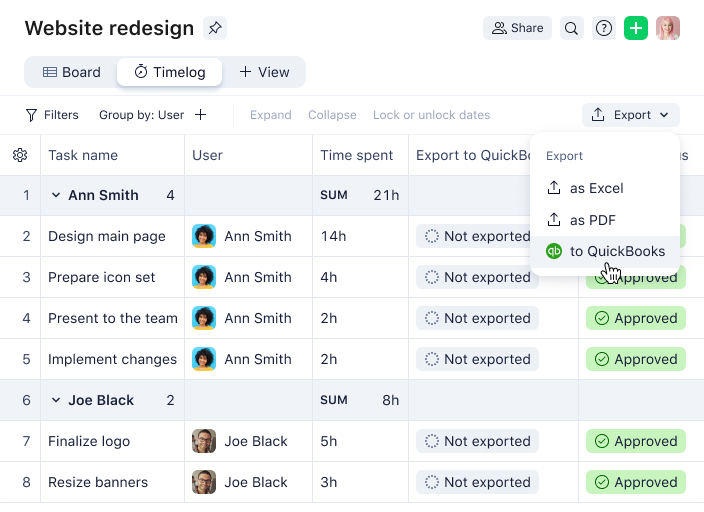
In a nutshell, the Wrike QuickBooks integration works by linking your entries from the employee time tracker to the program where you handle billing and budgeting. This makes it easier to invoice your clients and report accurately on your project finances.
There are massive advantages to this integration:
- You save time because you don’t have to scour timesheets, messages, and project reports when you want to find out about the billable hours that went into a project
- You avoid errors because you eliminate manual data entry
- You improve accuracy in your billing by basing it on Wrike’s concrete time tracking data
- You improve communication and team collaboration because the accounting team has easy access to the information they need
As well as manually exporting Wrike time entries to QuickBooks, you can automate your workflow to send the information from one platform to another when a task reaches a certain stage of your process.
Creating an automation rule is as simple as setting up a trigger, like a task status change.
For example, when a task in the project is approved, then sync the time entries with QuickBooks so your bookkeepers can use it to complete the processes they’re responsible for. Within Wrike, you can also clarify the specifics for synchronization, including the QuickBooks account you want to use and the fields for the invoice page.
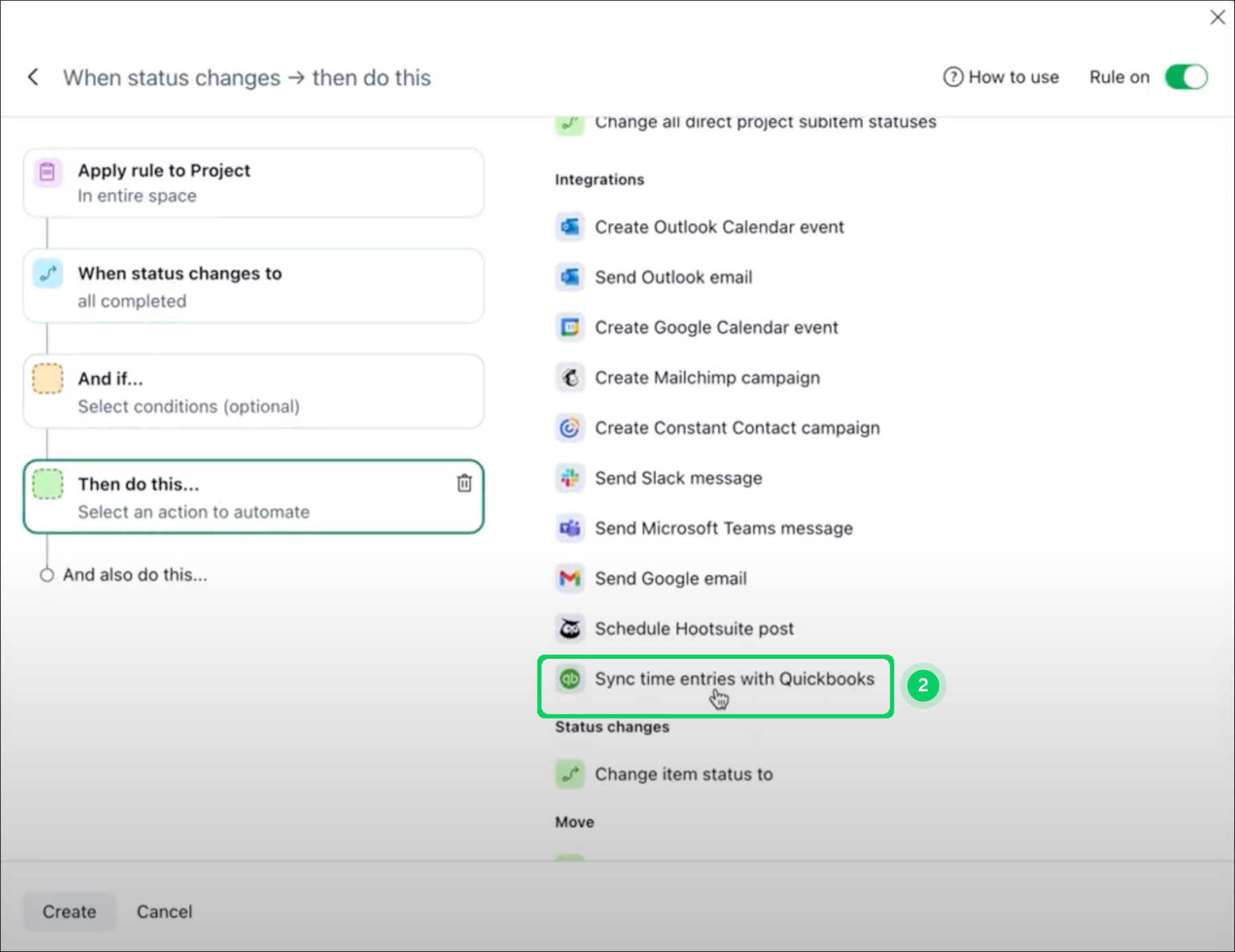
Once the automation is triggered, the selected time entries will be automatically exported to QuickBooks. Removing another manual stage from your workflow saves even more time, makes financial management an integral part of your team’s workflow, and eliminates accounting bottlenecks that could impact the rest of your project.
Wrike’s QuickBooks integration is available with a Wrike Pinnacle plan and a QuickBooks account with admin access. Find out more from our customer support team now.
4 reasons to choose Wrike as your project management platform
Knowing how seamlessly Wrike connects with QuickBooks is a good starting point. But if you’re exploring your options for new software, integration alone isn’t enough. You also need a project management solution that’s powerful and flexible enough to handle all the other tasks attached to your projects.
That’s where Wrike stands out.
Wrike is built for companies that handle large, complex, and overlapping projects. Whether you’re coordinating multiple initiatives and stakeholders or aligning your team behind one big piece of work, Wrike gives you the structure and oversight you need to stay on track.
To show how Wrike can support every phase of a project – while working hand-in-hand with your financial tools – I’ve outlined some of the key benefits below.
1. Align any size of team with ease
As your workload grows, one of the first things you’ll need is a reliable process for keeping your team aligned and informed.
While their projects are still smaller or simpler, teams often scatter their communications and file sharing across more basic project management tools. But once you start to scale, it’s far more effective to bring these different parts of your project together and create a hub where everyone can access the resources and updates they need.
Wrike is designed to help teams of all sizes collaborate smoothly. Your Wrike workspace acts as a central source of truth where you can share all the communication, documentation, and discussion around your project. When you have this solid, transparent foundation, it’s far easier to bring your team together and lead them to success. 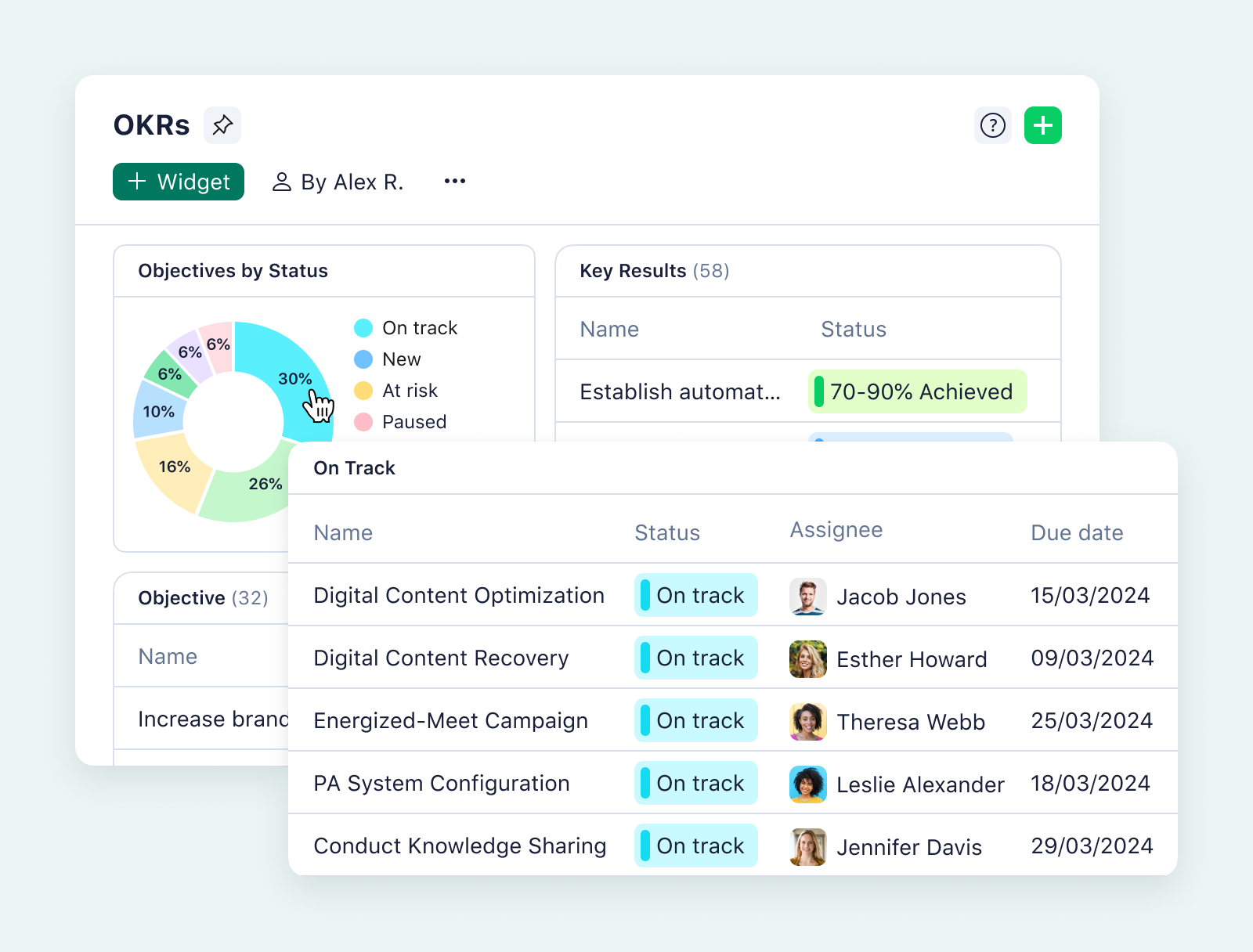
- Share automated workflow frameworks to standardize your business processes and bring all your project tasks up to the same rigorous standards.
- Centralize all your project communications in Wrike, with tools like @mentions, task histories, automated notifications, and comments directly on the documents and assets you share.
- Create real-time dashboards to display the latest project updates, connect your teams, and remove the need for progress meetings.
- Tailor your workspace to support your management style, with project management templates for Agile teamwork, Sprint planning, and project frameworks for a range of industries.
With these features, you can build a space that keeps your team on the same page throughout your project, and shows them how their work fits into the bigger picture.
2. Plan and resource your projects accurately
As your company takes on more work, project planning becomes increasingly important. You need tools to help you estimate the effort involved, allocate resources effectively, and control the project costs right from the start.
From the initial concept on, Wrike helps you define your deliverables and break the project work into clear, manageable tasks.
You can create custom item types to represent the work you have on your plate. Where larger tasks make it harder to estimate your cost or timeline, we’ll suggest ways to break them into smaller, more achievable subtasks. Then, once all these project items exist in your workspace, you can be sure that nothing will slip through the cracks once your project kicks off.
You can also use Wrike to visualize your project roadmap to share with your team and your stakeholders. Our management software makes it easy to convert tasks into milestones to track project progress, and you can set up automated task dependencies to make sure you’ve accounted for the ways your work overlaps.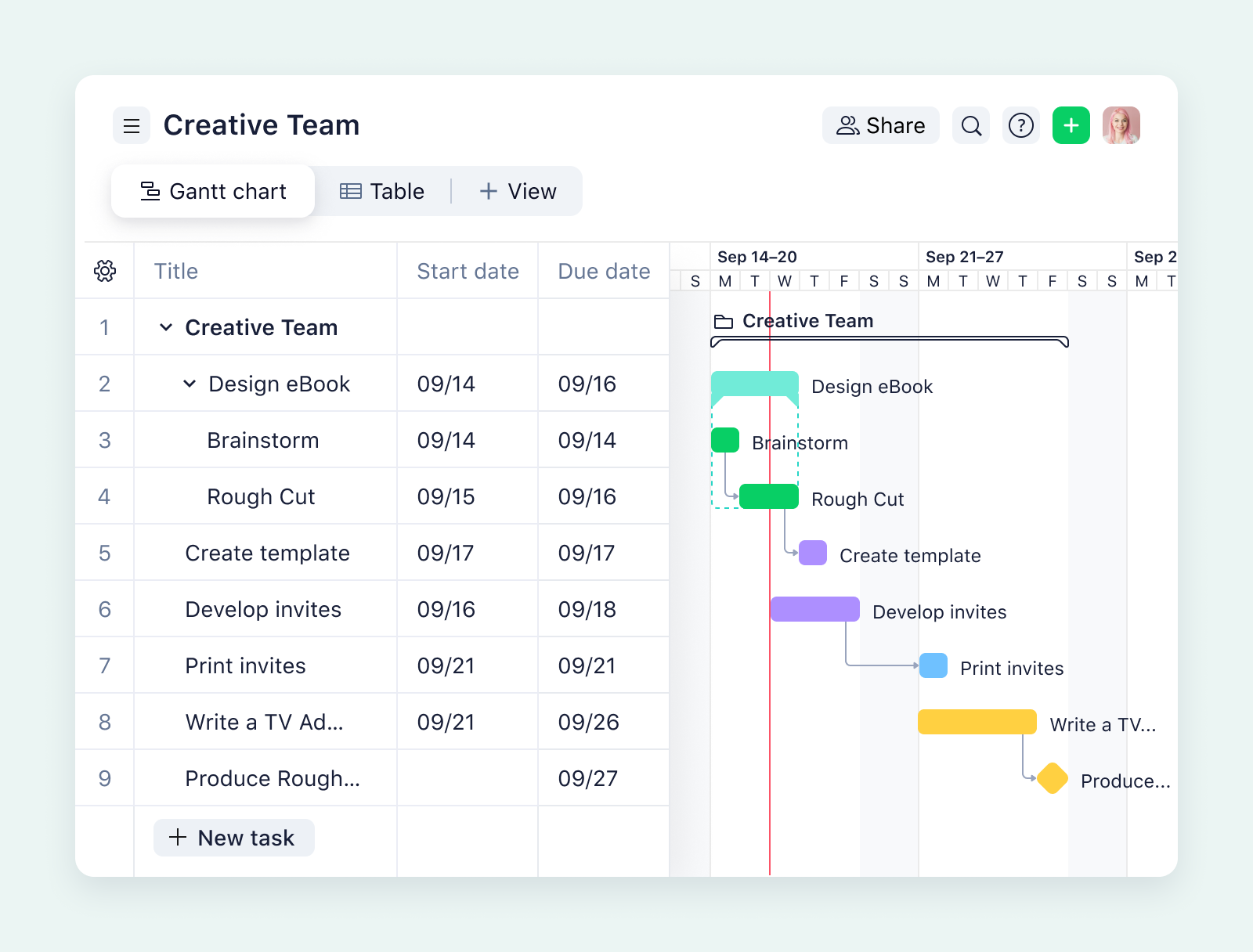
You can visualize your task list and processes in:
- Kanban boards, where the task cards present the project plan and meticulously track its history once work begins
- Table views listing all the key information about each task
- Gantt charts to visualize your timeline, the critical path for your project, and the task dependencies
- Shared calendars to help your team plan and prioritize their tasks, and keep the most important deadlines in view
When your work begins, you’ll see that all of these overviews are automated and responsive. Whenever a task changes status or is added to the beginning of your workflow, your dashboard will update to show the very latest information — and even let you know if the change puts one of your project milestones at risk.
This flexible setup gives you a strong start when you take on new projects, and the flexibility to adjust your plan once work begins.
3. Execute your projects seamlessly
Once your projects start, Wrike helps your teams prioritize their tasks and execute them in the smoothest way possible.
The best way to improve project execution is to keep your resources organized and document your process from end to end. With Wrike, you have:
- A clear project folder structure to save all your important project documents, like creative briefs, early drafts, design assets, and shared reports.
- Robust document workflows to save the comments and discussions on your tasks, route them to the person responsible for each new stage of the workflow, and store the final versions of your deliverables securely once they’re marked complete.
- Proofing, review, and approval tools to ensure your work is checked and rubber-stamped before the end of the project. Remember, you can also create workflows for your financial project management tasks or set up an automated export to the QuickBooks app at any point in the process.
- The innovative cross-tagging feature, which lets tasks exist in multiple folders and workflows simultaneously, and removes issues with file sharing and duplication.
Again, this feature is particularly helpful for aligning accountants with the rest of your project team, as they have access to the financial information as it’s recorded in the Wrike space, without disrupting the rest of the processes.

In terms of resource management, Wrike also gives you an edge during this phase of project management.
As your team uses Wrike’s inbuilt timetracker (either to record their hours live or to enter the data manually later), we’ll translate this data to show their capacity for new work. This means that, as well as helping you track the billable hours for each of your projects, Wrike also helps you manage your team to ensure they’re working to their full potential.
For example, when your capacity planning view shows that a team member is under capacity, you can automatically assign new tasks to them as they arrive. On the other hand, if you see that someone is over capacity and in danger of burnout, you can easily step in to change the task deadlines, supply them with additional resources, or reallocate the tasks to someone with more time in their calendar. They’ll be automatically notified of the changes, and you can continue to work toward the best results for your project.
4. Analyze your projects to learn and adapt
As your projects grow and develop, you’ll learn more about your process and the way your team works best. The best project management systems scale and evolve along with you, and Wrike is no exception.
Wrike remains fully customizable throughout the project lifecycle. At any point, you can refine your workflows, request forms, and dashboards to improve your overview and your results.
If feedback from your team suggests they’d like a calendar of upcoming meetings in their project dashboard, you can easily add a widget to meet that need. If your client management team finds that they’re still chasing crucial information from the new clients they’re onboarding, you can add a field to your request forms to gather it automatically. This flexibility keeps your teams agile and helps build a culture of continuous improvement throughout your organization.
As well as gathering feedback from your team, Wrike puts detailed reports and project analyses at your fingertips.
Our reporting and monitoring software provides the latest data about your projects and presents it in a clear, actionable format. With these automatically generated reports, you can examine your team’s performance, spot areas for improvement, and drill down to the root of the problem. 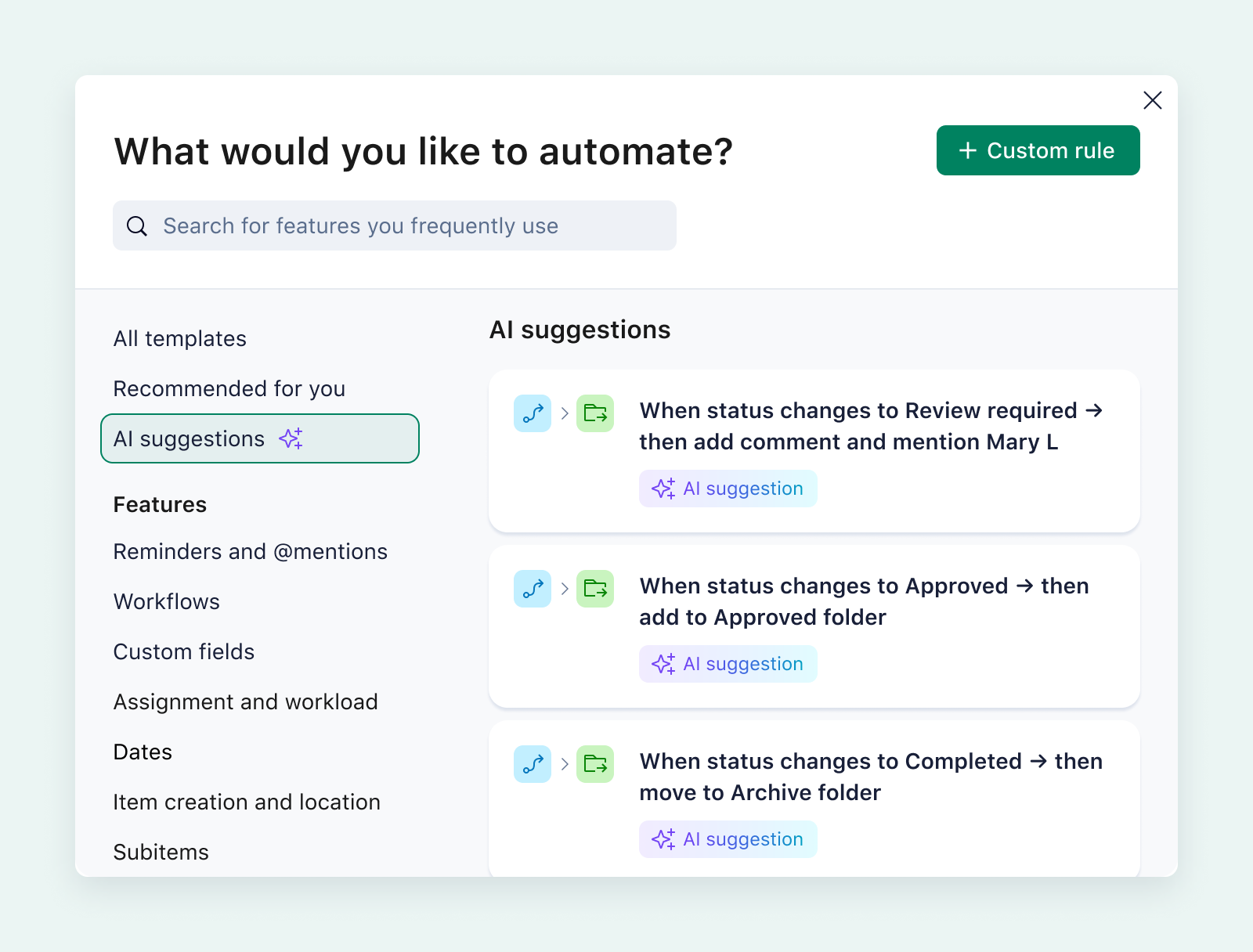
For seamless project and financial management, choose Wrike and QuickBooks
The best project management software brings together all the tools you need to meet your project goals. It’s all about closing the gaps in your process, measuring your progress accurately, and setting your team up for a smooth collaboration.
With Wrike, you have an all-in-one tool to cover every aspect of project management and adapt to any type of work. And with seamless integration via well-known tools like QuickBooks, you can keep your project finances up to date every step of the way.



